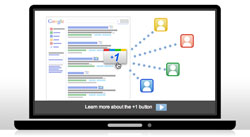Devs react to Google +1
Google's Like challenge seen as ill-conceived and unnecessary

The worst-kept secret of the web, Google's +1 button, is now live. A Google spokesperson told us: "Websites across the world will be able to add +1 buttons to their web pages [and] we're continuing to roll-out the +1 button for English-language searches on Google.com and other Google properties."
According to the +1 website, the button is "shorthand for 'this is pretty cool' or 'you should check this out'," but designers and developers are less convinced. Nine Four owner Nathan Pitman told us: "Like and Share are words non-geeks understand, but +1 means nothing to them". Others appear concerned that only Google benefits directly. Developer Brian Kennish believes the button "solves a problem for Google—getting interest data—but not for users, who will merely occasionally see people they email embedded in search results pages". Designer Josh Emerson thinks it's "understandable that Google would want to gather yet more data", given that it's the company's business model, but he asks if we want to acquiesce: "There's an understandable fear around a company having so much influence, but what evil can they inflict once they know what we 'like'? Perhaps it's an irrational fear, but it's good to be cautious when it comes to monopolies."
Searching for relevance
Clearleft co-founder Richard Rutter wonders if this is merely another land-grab by Google: "My initial feeling is that we don't need another 'like' button. This just seems like another attempt by Google to move into the 'social web' space and grab some of Facebook's territory. They've failed miserably so far, and I can't see this helping." Happy Cog founder Jeffrey Zeldman agrees: "Google trying to be Facebook is like Yahoo trying to be Google, and we all remember how that worked out."
Developer David Dixon's thoughts are also along similar lines, and he doesn't see how +1 can succeed in the same manner as Facebook's and Twitter's equivalent buttons. "Search engines are only used as a route to content. If I find the content, I don't come back to Google, so to make use of +1 I'd have to change my browsing habits to give feedback or only comment on links that I feel are not relevant," he says. Dixon reckons the second of those things is what Google should really concentrate on, to weed out irrelevant and spammy results: "Google's also far more likely to get valuable feedback from bad results than good ones—people are often more vocal when complaining!"
Designer James Baker offers a contrary viewpoint, arguing that Google shouldn't be getting into the 'like' game at all: "Unlike social sites, Google trades on the perception of impartiality. +1 therefore seems dangerous and comes across as another way to game the search results system." He wryly adds that this could be a great opportunity for Bing "if they weren't always so keen to follow what Google does". Harry Brignull, Senior UX Designer at Clearleft, also wonders about Google entering the social space: "What matters is not the recommendation data itself but who gets to see it. With Facebook, when you 'like' something, your recommendation can be seen by your Facebook friends, a list you've curated over many years, hence why Facebook 'likes' are high-value. With Google, your social graph is not something you have personally curated. In typical Google style, they've tried to automate the process of social-graph creation by mining publicly available friend data on the web. But if someone sees +1s from people they don't care about, it's just noise."
The motivation problem
Dan Ruffle, Lead Designer, Metakinetic Ltd, was one of the few people we spoke to who were positive about +1, calling it a "huge step forward for Google in gaining a share of the market Facebook and Twitter currently dominate". He's keen to see how "the interaction with +1 affects the level of communication between friends and search results", and thinks "passing search results through a social sieve will be interesting and produce more relevant results".
However, Metakinetic Director Darren Bull reckons that while website owners can't afford to ignore +1, because it will "see very high levels of adoption, particularly in the ecommerce sector, where product ranking in search engines is a key influence of online retail success," he's concerned user adoption may—like other Google social experiments—be a problem: "With current Twitter and Facebook behaviours both established, habitual and closely linked with the user's social groups and communities, it will be interesting to see what motivation Google provides for the end user to '+1' rather than 'like' or 'retweet' something." And Web Developer Mike Mackay thinks some developers will also need motivating: "As a digital agency, we've not decided whether we will actively implement Google's +1 on our clients' sites yet. Of course, if the client specifically requests it we will add it, but for now, Facebook and Twitter are adequate."
Daily design news, reviews, how-tos and more, as picked by the editors.

The Creative Bloq team is made up of a group of art and design enthusiasts, and has changed and evolved since Creative Bloq began back in 2012. The current website team consists of eight full-time members of staff: Editor Georgia Coggan, Deputy Editor Rosie Hilder, Ecommerce Editor Beren Neale, Senior News Editor Daniel Piper, Editor, Digital Art and 3D Ian Dean, Tech Reviews Editor Erlingur Einarsson, Ecommerce Writer Beth Nicholls and Staff Writer Natalie Fear, as well as a roster of freelancers from around the world. The ImagineFX magazine team also pitch in, ensuring that content from leading digital art publication ImagineFX is represented on Creative Bloq.
